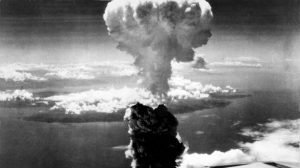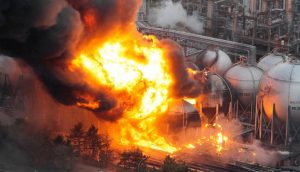The TrickyScribe: Hell broke loose on the twin cities of Hiroshima and Nagasaki 72 years back! Fat Man was dropped from Boeing B-29 Superfortress Bockscar, piloted by Major Charles W Sweeney, on Nagasaki unleashing roiling mushroom cloud in the first-ever nuclear war that the world saw.

Nagasaki Explosion, Credit: Google
Fat Man was an implosion-type nuclear weapon with a solid plutonium core that left an estimated 35,000–40,000 people killed. Most of the direct deaths and injuries sustained from the bombing were munitions or industrial workers.
Remembering the victims of Nagasaki Bombing, Mayor, Nagasaki, Tomihisa Taue on Wednesday said the nuclear threat will not end as long as nations continue to claim that nuclear weapons are essential for their national security.
He said that Nagasaki must be the last place to suffer an atomic bombing.
Sino-India Dispute
With China and India clashing over a remote Himalayan plateau of Doklam since mid-June, Chinese and Indian soldiers lined up “eyeball to eyeball” bringing 2.6 billion people at loggerheads, the world is at an inevitable risk of a massive full-scale nuclear war.
And that’s not a great prospect given that both the countries have the possession of nuclear-tipped missiles. Simmering dispute may have serious implications. Detrimental to both!
Fukushima Disaster

Fukushima Disaster, Credit: Google
Even as the nuclear disaster at Fukushima Daiichi was not as disastrous as a full-scale nuclear war can be, the results are nowhere near normal. The Japanese government claiming the Fukushima disaster is “over,” experts including Arnie Gundersen, who managed and coordinated projects at 70 US atomic power plants, are not amused at all.
He is a licensed reactor-operator with over four decades of experience in nuclear power engineering and author.
The disaster not ‘over’
It’s not just the government, but the International Olympic Commission is burning the midnight oil to normalize the situation, even though conditions at Fukushima are anything but normal. The commission even has plans for the 2020 Tokyo Olympics to have baseball and softball games played at Fukushima.
The ‘home’ no longer habitable
Reports of radiation from the Fukushima Daiichi nuclear disaster, triggered by a tsunami generated by Japan’s deadly earthquake in 2011 struck the nuclear plant, have been ongoing.
The disaster left region of 310 square miles around the plant uninhabitable. More than 1.5 lakh residents were subjected to evacuation. Although some of them are back to their homes, more than half of the evacuees rehabilitated in a nearby town would not return to their homes even if evacuation orders were lifted, said a 2016 survey.
Thyroid cancer cases
Japanese media recently reported seven more people who used to live in Fukushima, Japan were diagnosed with thyroid cancer, the government announced in June. This brings the number of cases of thyroid cancer of those living in the prefecture at the time the disaster began to at least 152.
Claims of denying any correlation between these cases and the Fukushima disaster by the Japanese government notwithstanding, thyroid cancer has long since been known to be caused by radioactive iodine released during nuclear accidents like the one at the Fukushima Daiichi power plant.
A World Health Organization report released immediately after the disaster started listed cancer as a possible result of the meltdown, and a 2015 study in the journal Epidemiology suggested that children exposed to Fukushima radiation were likely to develop thyroid cancer more frequently.
Total Views: 3,18,960
